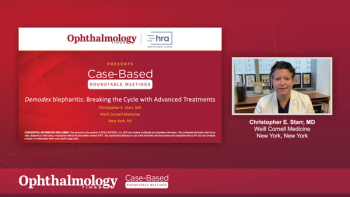Demodex blepharitis: Breaking the Cycle with Advanced Treatments

A panelist discusses how demodex blepharitis presents with distinctive symptoms like eyelash itching, colorettes at the base of lashes, and can significantly affect pre-surgical cataract measurements, requiring treatment before proceeding with surgery.

A panelist discusses how treating ocular surface disease and demodex blepharitis before cataract surgery led to improved refractive measurements, resolved corneal staining, and enabled successful multifocal IOL implantation in a patient who had previously shown irregularly irregular topography patterns.

A panelist discusses how demodex blepharitis frequently co-occurs with other ocular surface conditions in younger patients, as illustrated by a 35-year-old contact lens wearer who presented with recurrent styes, contact lens intolerance, and a history of rosacea.

A panelist discusses how treating demodex blepharitis with Lotilaner not only eliminates the anterior blepharitis symptoms but also improves meibomian gland function, with low recurrence rates after treatment and significant benefits for patient comfort and quality of life.





.png)


